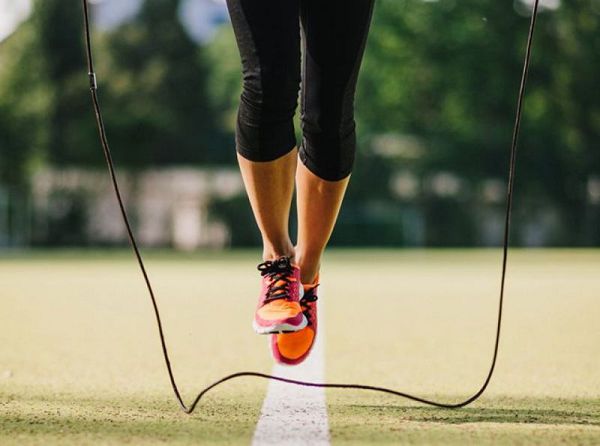
Jumping rope is a great alternative to running, cycling, and other physical activities that can help you lose weight. Using jumping rope to lose weight, you, among other things, train the cardiovascular system, strengthen muscles, increase and even stabilize blood pressure.
Let’s take a look at what the jumping rope technique should be, and what muscles work in this type of physical activity.
How to jump

Not everyone knows how to use this wonderful jumping line. Many cannot jump several times. The older a person is, the more difficult it is to learn. This is due to two characteristics of an adult personality – psychological and physical. The first is due to the constraint of others and a lack of faith in oneself. The second is more ambitious – these are the restrictions that age imposes on us. Over the years, it is difficult for an untrained body to clearly coordinate the activity of the muscles. In simple terms, even jumping rope will be difficult.
Therefore, the first step to jumping is training without a rope. It is important to train the calf muscles for long-term work. One way is to jog on your toes. The second is low jumps in place. Your task is to slightly tear the sock off the floor. You need to jump on your toes.
If you find out how many calories are burned when jumping rope, then give up running and other forms of cardio. By the way, we will talk about which is better to prefer, a jump rope or a run. A set of rope exercises significantly simplifies fat burning – this is a proven fact.
You need to jump on your toes very low, barely lifting your feet from the surface of the floor – the higher you jump, the worse for the joints of your legs. Never land on your heels.
For a start, a simple scheme will suit you – jump for 10 seconds. Easily? Let’s jump a minute. Then rest for 60 seconds. Jump again. Do these 3-4 cycles. It’s not bad if you can reach 2-3 minutes of jumping without stopping. When it became very easy to jump, jump in the same way, but on one leg.
Now you are ready to use the rope for weight loss.
How to jump rope:
Go outside or exercise in a high-ceilinged area.
Take the rope so that it is easy to twist it with the effort of only one of the wrists.
Take the cord behind your head to your heels. Make a swing, jump, slightly bending your knees.
Depending on the type of exercise with a skipping rope for weight loss, you need to jump in the usual way, sweeping your legs back, dashes or on one leg. In any case, jumping rope first starts from the starting position, and you can make the next step special.
The length of the “trainer” must match your height. A cord that is too short will prevent you from jumping – you will stumble. Too long can brake on the floor or hit the ceiling. In general, an incorrectly chosen length can ruin the whole event.
What muscles will work
Jumping, in conjunction with arm movements, will use the calf muscles, back, and hands. If you move your arms at the expense of the elbow joint, the forearms will also work. Usually only the hands work unless complex jumping maneuvers (such as cross jumps) are used.
What muscles work when jumping rope in the end:
calf muscles,
arm muscles,
muscles stabilizing the vertical position of the body.
How to lose weight with jumping
Jumping rope for weight loss helps you burn more calories than regular walking. Even a bicycle does not require as much energy from you as this activity does.
Cardio jumping rope is a popular alternative to pre-workout jogging. This is a typical warm-up for fighters of various melee styles. But the choice of running or jumping rope should always be yours. When you run, you can likewise lose weight in your legs, arms, and your entire body. The differences are more in convenience – you won’t be able to run everywhere. But jumping for weight loss can be practiced even at home. If the ceiling is low, jump without a rope.
Rope training should be done on an empty stomach. After eating, 1.5 hours should pass. If you drink and start jumping, you will feel an unpleasant sensation in your stomach, hear a gurgle. It is harmful, do not allow it.
The effectiveness of the lesson will depend on the number of jumps per minute. They say that 100 jumping rope is the maximum. Take it upon yourself to prove that it is not.
Do you know how many calories jumping burns? Approximately 200-300 in 15 minutes of the process for a person weighing 60-80 kg. Naturally, no one will do this for an hour. And 15 minutes is quite possible. Three hundred calories is about 400 grams of bananas (3-4 pieces) or almost a liter of Coca-Cola (rounded off).
Those who want to lose weight, can you imagine how much it will cost you another portion of a delicious and juicy hamburger? It will cost you almost half an hour of jumping.
Rope exercises
Just jumping is boring. Therefore, you can perform any set of exercises with a rope.
Jumping rope can be done in different ways – you can jump, crossing your arms, jump high. Double jumping rope or even triple jumps, as well as swing jumps, are common. The first means that the number of circles that the rope makes around you in one jump is 2 or 3, and the second that you make more sweeping movements with your hands than usual.
Different types of jumping rope are all sorts of exercises that are obtained if you combine bouncing with arm swings, foot stepping and other movements. By combining these exercises, you can diversify the traditional jumping rope. But, of course, it’s easier to just jump for a few minutes and then rest.
Jumping or running
Let’s go back to the question – run or jump. Better running or jumping? What shakes the legs more efficiently, is it possible to achieve the same effect with the help of a rope as when running?
In fact, both options can put a lot of stress on your body. Both options are suitable for those who have doubts about how to lose weight. Therefore, which is better, running or jumping rope is an incorrect question.
And with the help of a skipping rope, you can lose weight. With the help of running, too. Both can give you high calorie burn and slim legs. The main question is what is more to your liking – jumping for weight loss or a treadmill. In both cases, you will get the result. It’s like a bicycle or an ellipsoid – the choice is difficult, but it doesn’t really affect the achievement of the goal.
If you can’t decide what suits you better, running or jumping rope, you can combine them in your training process. In one workout, you can run as a warm-up, and in the next, you can jump. You can just start with a run and end your workout with jumping. There are a lot of options.
Every type of cardio is a workout for the heart. Systematic exercises in this direction allow you to optimize the work of the circulatory system so as to exclude oxygen starvation of all organs and tissues of our body. This is important because, thanks to stable nutrition and respiration, each cell will function fully, working for the benefit of your health.
Do I need to keep tables and draw up programs
Many believe that it is necessary to keep records everywhere, therefore they use a table for jumping rope for weight loss. They write all their achievements there. This is correct, as such documentation of your sports activity allows you to analyze your results.
The jumping rope table will be useful, as you can always see the history of the lessons and build a further training strategy.
The rope jumping program is the same plan in which you will ask yourself quite achievable tasks. If you are able to fulfill them, you are well done.

Benefit and harm
Let’s consider such a moment as well. Besides the effect of weight loss, does jumping rope benefit or harm our body? Who can practice them and who can’t?
From what jumping rope gives, you can list endurance, strengthening muscles and improving blood circulation. But what to choose, for example, running or jumping rope? The issue is controversial. Jumping is not a good option for everyone.
For example, a disease such as arthritis can greatly ruin the picture – it will hurt to jump. Obesity also interferes with this activity, since the load on the joints will turn out to be too great. Obese people find it difficult to jump on one leg, and sometimes on two. It is easier for them to get a sprain or fracture.
The harm from jumping is the effect on the joints. They wear out, get injured, and with high jumps there is an absolutely unnecessary load on your knees. You should be guided by your well-being. If during the lesson or after discomfort appeared in the feet, knees, hip or lower leg, it is better not to practice active jumping rope.
Jumping rope increases heart rate and breathing. It is recommended for untrained people to start with a leisurely rise on toes every 100–150.
So, what is useful for jumping rope: they strengthen the heart, lungs, muscles. You can only get harm if you get carried away and forget about the sensations in your body. Pain and extreme fatigue are unwanted sensations in any workout. Also, jumping long every day can cause overwork in the calf muscles. The consequences are constant aching pain while walking and even at rest.
It is said that the benefits of jumping rope also lie in endurance training. This is a very relative statement. What endurance are we talking about? If about the opportunity to make active movements and not choke after the first minute, then – yes. But if we are talking about muscle endurance, then only partially. Jumping trains calf endurance. Just like squats – hip endurance.
Источник — FitNavigator.ru
https://fitnavigator.ru/kardio/pryzhki-na-skakalke.html



